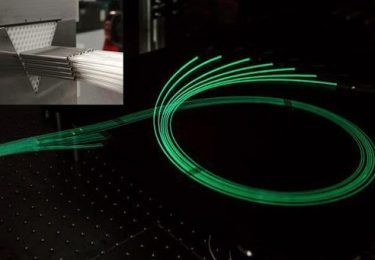Double clad fibers
Our ytterbium-doped and thulium-doped double-clad fibers offer the largest single-mode cores in the world. The high numerical aperture for the pump core/inner cladding lets you pump with high efficiency, even with inexpensive or high-power broad-area emitting pumps.
The single-mode signal travels in the large mode area to give high power levels and prevents nonlinearities.
Our passive double and single-clad fibers match our active fibers.

Key Features
Single-mode with large mode area
Handles high pulse energy
High NA circular pump core
High pump absorption, no skew-rays
Excellent power handling
High reliability
Double-clad ytterbium and thulium fibers made with photonic crystal fiber technology are known as air-clad fibers and provide a range of new benefits: The extremely high numerical aperture (NA) for the pump core/inner cladding is possible, allowing efficient pumping with inexpensive/high power broad area emitting pumps.
The large mode area for the single-mode signal facilitates high power levels while avoiding nonlinearities and providing a good overlap between the pump guide and the signal guide area (= high pump absorption, high efficiency).
The fibers have efficient mode and ray scrambling even for circular pump cores and the all-glass design has a much higher damage threshold than standard double-clad fibers.
The Single-Mode Advantage
All our fibers are single-mode leading to several advantages compared to standard multimode LMA fibers:
- Better output stability
- Excellent beam quality
- No need for tight coiling
- No coiling-induced mode area compression
See also our white paper on DC-200/40-PZ-Yb modal properties
The output of the ytterbium-doped DC-200/40-PZ-Yb fiber from NKT Photonics where the 1064 nm seed laser (≈6 µm spot size) launch position is scanned across the input facet of the fiber. Only the fundamental mode (LP01) is present in the output beam.
When the input launch position is changed the mode profile is maintained but with reduced power. This demonstrates the single-mode property of the DC-200/40-PZ-Yb.
Also available as a module
Did you know that our aeroGAIN-BASE modules are based on our DC-200/40-PZ-Yb fiber? If you do not want to work with fibers, these modules may be the solution.
Want more details?
If you want more details about how to handle optical fibers: Strip, cleave, and couple them, we have some application notes for you.
Optical fibers require proper handling to ensure a long lifetime and prevent fiber breaking. Read this guideline to learn how to handle optical fiber to keep both the fiber and operator safe.
Read this application note if you want to learn how to handle our optical fibers, e.g., including how to strip the protective coating, how to cleave the fibers, and how to couple light to and from the fibers.
Learn about optical damage of fiber facets in pulsed laser systems and how these depend on the pulse length.
Fiber amplifiers for ultrafast high-power fiber lasers require large core designs to suppress nonlinear effects and handle high heat loads. Read about the design, modal properties, and typical performance of the DC-200/40-PZ-Yb fiber.









